Supply Chain Test #2
1/134
Earn XP
Description and Tags
Name | Mastery | Learn | Test | Matching | Spaced |
|---|
No study sessions yet.
135 Terms
Procurement
process of selecting suppliers, negotiating contracts, establishing payment terms, and purchasing goods and services vital to an organization
Purchasing
The transactional function within procurement involving obtaining goods or services in exchange for money from a third party
Purchase Requisition
internal document notifying purchasing personnel of necessary items to order, quantity, and timeframe
does not constitute a contractual relationship with external party
Purchase Order (PO)
official offer from a buyer to a seller to acquire goods or services, controlling the purchasing process from external suppliers
Request for Information (RFI)
A standard process to collect information about supplier capabilities
Request for Proposal (RFP)
A detailed document to determine a supplier's capability and interest in producing a product or service
Request for Quote (RFQ)
document to solicit bids from interested and qualified suppliers for goods or services
Purchasing objectives
to ensure an uninterrupted flow of materials and services at lowest total cost
to improve the quality of the finished goods
to optimize customer satisfaction
Purchasing process steps
Identify need; issue Purchase Requisition
Obtain authorization
Identify and evaluate potential suppliers
Select supplier
Skip if you did this in Step 3
If not, initiate competitive bidding process
Purchase order is created and delivered to supplier
Supplier confirms purchase order
Order fulfillment
Receipt of goods
Invoice and reconciliation
3-way match - invoice, purchase order, and goods receipt must match
Payment
Close out the purchase order
Analysis
Measure efficiency and accuracy of procurement process
e-Procurement
web-enabled automation of non-strategic and transactional activities, such as:
RFI, RFP, RFQ
Execution and analysis
Reverse auction capabilities
increases visibility
e-Procurement process
Electronic purchase requisition and/or purchase order
Invoice
Payment
advantages of e-Procurement
Time savings - reduction in time between need recognition and the release and receipt of an order
Cost savings - lower overhead costs in the purchasing area
Accuracy - a reduction in errors; virtual elimination of manual paperwork
Real time - improved communication both within the company and with suppliers
Management - purchasing personnel spend less time on processing of purchase orders and invoices, and more time on strategic value-added purchasing activities
Mobility - access virtually anywhere
Trackability - real-time status tracking
Total Cost of Ownership (TCO)
the sum of all the costs associated with every activity
Purchase price of an item is very important, but it is only one part of this
= Quality + Service + Delivery + Price
Components of Total Cost of Ownership
Pre-transaction costs - activities carried out prior to the actual buy and sell transaction
Transaction costs - activities carried out as part of the actual buy and sell transaction
Post-transaction costs - activities carried out following the actual buy and sell transaction
Make vs. buy decision
The strategic decision of producing internally or buying from an external supplier based on business strategy, risks, and economic factors
Make vs. buy decision key pillars
Business strategy
Risks
Economic factors
Qualitative reasons for making
Protect proprietary technology - not wanting your intellectual property to be public
No competent supplier - in the market and you may not want to spend the time or effort to develop one
Control of lead-time - feeling you have more control over the lead time to produce the product
Use existing idle capacity - make use of excess capacity
Better quality control - feeling you have more control of the quality of the material/product than a supplier
Quantitative reasons for making
Overall lower cost
Control of transportation and warehousing costs - avoid transportation costs and potentially keep warehousing costs low
Qualitative reasons for buying/outsourcing
If it is a non-strategic item
Insufficient capacity
Temporary capacity constraints - concept of “extended workbench” (i.e., short-term supplementing internal capacity with external capacity during time of constraint or overloaded work centers)
Lack of expertise - or necessary technology
Quality - suppliers may have better technology, process, & skilled labor
Multi Sourcing Strategy - using an external supplier + an internal source
Brand Strategy - take advantage of a supplier’s brand image, reputation, popularity, etc.
Quantitative reasons for buying/outsourcing
Cost advantage - suppliers may provide the benefit of economies of scale, esp. for non-vital components
Inventory considerations - opting to have the supplier hold inventory of the item or the materials required to produce the item
Benefits of outsourcing
Concentrate on core capabilities
Reduce staffing levels
Accelerate reengineering efforts
Reduce internal management problems
Improve manufacturing flexibility
In-sourcing
reverting to in-house production when external quality, delivery, and services do not meet expectations
Co-sourcing
internal staff and an external provider share a process or function
using exclusive dedicated staff as an external provider
Backward vertical integration
a company acquires one or more of their suppliers
Forward vertical integration
a company acquires one or more of their customers
Profit-leverage effect
Decrease in purchasing expenditures directly increases profits before taxes
Return on Assets (ROA) effect
a high [this] indicates managerial expertise in generating profits with lower spending
= Profit / Assets
Centralized purchasing
purchasing department located at the firm’s corporate office makes the purchasing decisions for all departments
advantages
Concentrated volume
Leveraging purchase volume
Avoiding duplication
Specialization
Lower transportation costs
No competition within units
Common supply base
Decentralized purchasing
individual, local purchasing departments make their own purchasing decisions
advantages
Knowledge of local requirements
Local sourcing
Less bureaucracy
Hybrid approach (centralized/decentralized purchasing)
centralized purchasing for products and services used throughout the corporation
decentralized purchasing for products and services used only locally at each facility
Specialized Knowledge
Essential for international purchasing
Tariffs - duties, taxes, or customs imposed by the host country on imported/exported goods
Non-tariff barriers - quotas, licensing agreements, embargoes (i.e., official ban on trade with a particular country), laws and regulations imposed on imports and exports
Countertrade - international trade by exchange of goods rather than by currency
Bid
a proposal or quotation submitted in response to a solicitation from a contracting authority
Competitive Bidding
competing suppliers bid for the right to supply specified materials or services
no negotiations—contract goes to cheapest responsible bidder
Purchasing function
enhances value
performance is preferably monitored periodically against standards, goals, and/or benchmarks
Strategic Sourcing
comprehensive approach for locating and sourcing key suppliers, so that an organization can leverage its consolidated purchasing power to find the best possible values in the marketplace
emphasis on product life-cycle
how it works
Identifying suppliers
Cultivating relationships
Continuously improving skills
Understanding and embracing the possibilities
Objectives of strategic sourcing
Improve the value‐to‐price relationship
i.e. achieve cost reductions while maintaining or improving quality/service
Understand the category buying and management process to identify improvement opportunities
Examine supplier relationships across the entire organization. Share best practices across the organization
Develop and implement multi‐year contracts with standardized terms and conditions across the organization
Leverage the entire organization’s spend
Sourcing Strategies
Insourcing - producing goods or services internally
Outsourcing - traditionally involves purchasing an item or service externally, which had previously been produced internally
Recently: term has become synonymous with the concept of buying an item from an external supplier regardless of whether the item had previously been produced internally
Single-source - a sourcing strategy where there are multiple potential suppliers available for a product or service, but the company decides to purchase from only one supplier
RISKY
Multi-source - purchasing a good or service from more than one supplier
creates competition between suppliers to achieve higher quality and lower price
Reasons for single supplier
To establish a good relationship
Less quality variability
Lower cost
Transportation economies
Proprietary product or process
Volume too small to split
Reasons for multiple suppliers
Need more capacity
Spread risk of supply disruption
Create competition
More sources of information
Dealing with special kinds of business
Functional products
MRO items and other commonly low profit margin items with relatively stable demands and high levels of competition
Ex.: office supplies, food staples
Potential strategy: reliable, low cost multi-sourced suppliers
Innovative products
have short product life cycles, volatile demand, high profit margins, and relatively less competition
Ex.: technology products such as iPhone
Potential strategy: innovative, high-tech, cutting edge, market leading single-sourced supplier. Long-term partnership
Strategic sourcing process
Identify the targeted spend area
Create the sourcing team
Develop a team strategy and communication plan
Gather market information
Develop a supplier portfolio
Develop a future state
Select suppliers and negotiate
Implement Supplier Relationship Management (SRM)
Spend analysis
Categorizing and analyzing expenditure data to decrease costs, improve efficiency, and monitor compliance
key areas
Total historic expenditures and volumes
Future demand projections or budgets
Expenditures categorized by commodity and sub-commodity
Expenditures by division, department, or user
Expenditures by supplier
Spend analysis process
Define the scope
Ex.: expenditures over a specified period
Identify all data sources
Gather and consolidate all data into one database
Cleanse the data (i.e., correcting errors) and standardize it for easy review
Categorize the data
Ex.: commodity and sub-commodities
Analyzing the data for:
Best deals per supplier
To ensure that all purchases are from preferred suppliers
To reduce the number of suppliers per category
Repeat the process on a regular basis
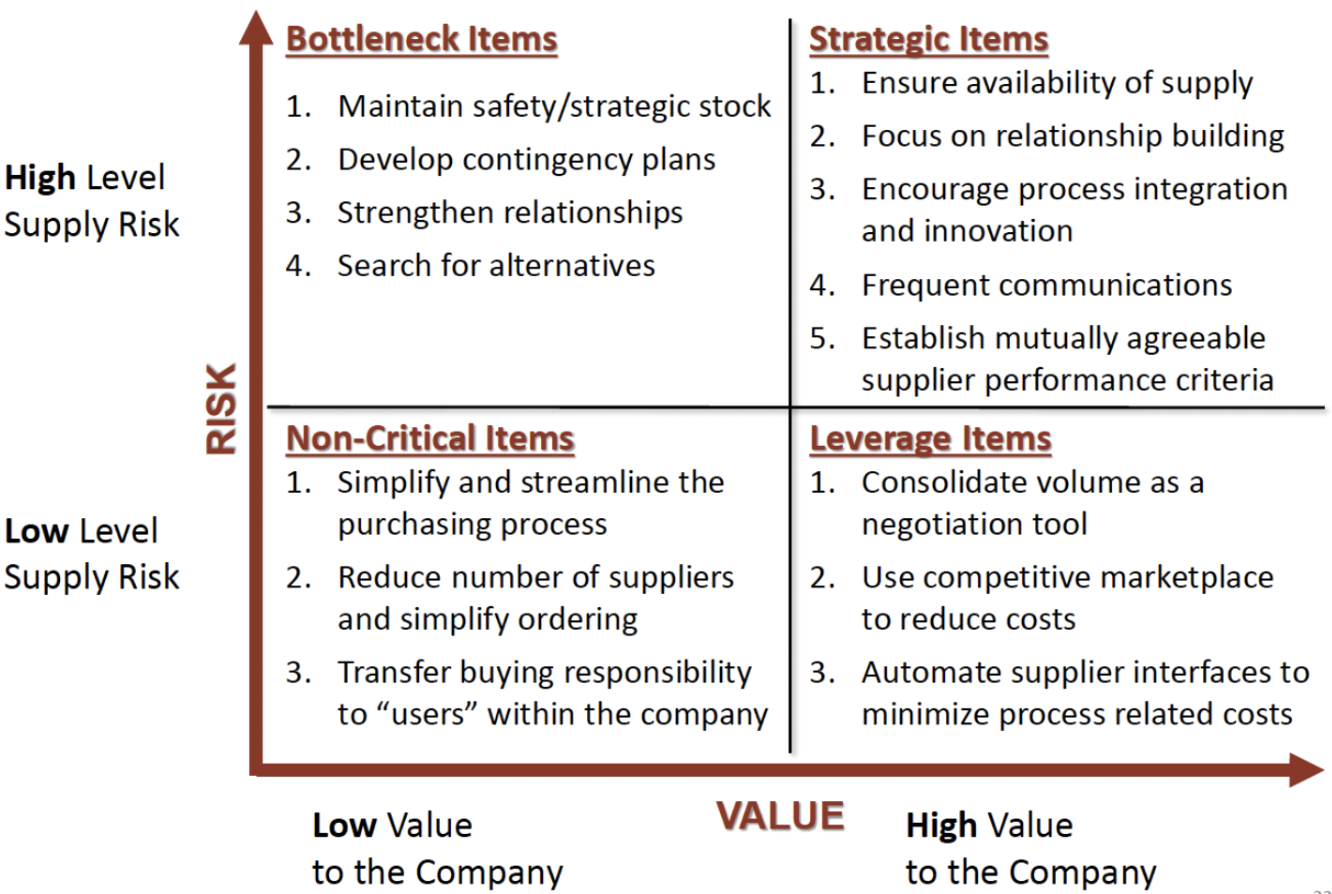
Sourcing strategies by category
non-critical, bottleneck, leverage, and strategic items
Non-critical items
involve a low percentage of the firm’s total spend and involve very little supply risk
Ex.: standard screws in a computer factory
Bottleneck items
unique procurement problems. Supply risk is high and availability is low. Small number of alternative suppliers
Leverage items
commodity items where many alternatives of supply exist, and supply risk is low. Spend is high and there are potential procurement savings
Strategic items
involve a high level of expenditure and are vital to the firm’s success
Sourcing categories examples
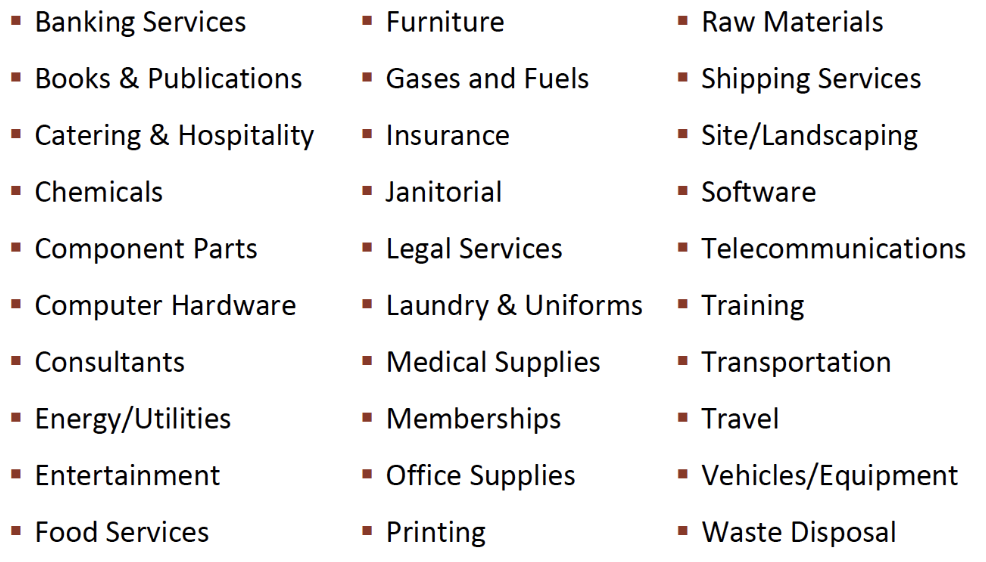
Supply base rationalization (/reduction/optimization)
reducing the supply base as much as possible without significantly increasing risk
results in:
Reduced purchase prices
Fewer supplier management problems
Greater levels of quality and delivery reliability
Closer and more frequent interaction between buyer and supplier
AI in supplier selection
can increase effectiveness of supplier relationship management
eliminates human error
can quickly and thoroughly analyze supplier-related data (e.g., on-time, in-full delivery performance, evaluations, and credit scoring) and provide information for future decisions
can improve customer service
Preferred suppliers
Best meet your company’s overall purchasing requirements
Achieve a specific and exceptional level of performance over time as measured by agreed-upon criteria, providing higher value than competitor
they provide
Product and process technology and expertise
Product development and value analysis
Information on latest trends in materials, processes, or designs
Capacity for meeting unexpected demand
Cost efficiency due to economies of scale
Strategic alliance
A sourcing agreement between a buyer and a supplier to pursue agreed-upon objectives while remaining independent organizations, sharing information and resources for mutual benefit
benefits
Potential to increase profits for both parties
Potential to create a competitive advantage or block a competitor from gaining market share
Mitigate risks and ensure a continuity of supply
Position the partners for future strategic opportunities
Strategic alliance development
an extension of supplier development which refers to increasing a key or strategic supplier’s capabilities
Results in:
better market penetration
access to new technologies and knowledge
higher return on investment
Distributive negotiations
leads to self-interested, one-sided outcome
counterproductive - parties work against each other; lose-lose
competitive - compete for value and barely share info; win-lose
Collaborative negotiations
Both sides work together to create a win-win result, requiring open discussions and alignment on motivation, contribution, and financial benefit
cooperative - parties work tg and trust each other
collaborative - same goals and parties work tg to create new opportunities and solve problems
Reverse auction
pre-qualified suppliers bid against one another to secure the buyer’s business, driving the price to be paid for the item downward
Vendor Managed Inventory (VMI)
Suppliers directly manage buyer inventories to reduce carrying costs and avoid stockouts, determining delivery schedules and order quantities
From buyer-firm’s perspective:
Supplier tracks inventories
Supplier determines delivery schedules and order quantities
Buyer can take ownership at the stocking location
Buyer may also be able to avoid taking ownership until the material is actually being used
From supplier’s perspective:
Avoids ill-advised customer orders
Supplier decides inventory set up and shipments
Opportunity for supplier to educate customers about other products
Co-managed Inventory (CMI)
a specific quantity of an item is stored at buyer’s location, and supplier replaces it with approval from buyer when stock is depleted
supplier only recommends orders and requires approval
Supplier co-location
Supplier representative embedded in the buyer's purchasing group to forecast demand, monitor inventory, and place orders, benefiting both parties
employee is paid by supplier but works for buyer
Business Ethics
Corporate social responsibility (CSR) - the practice of business ethics
2 main ethical approaches
Utilitarianism - an ethical act is one that creates the greatest good for the greatest number of people and should be the guiding principle of conduct
Rights and duties - some actions are just right in and of themselves, regardless of the consequences
Supplier Relationship Management (SRM)
Strategically planning and managing interactions with third-party suppliers to maximize value
defining needs and wants and establishing company links to obtain them
part of Strategic Sourcing rollout
best supplier candidate traits
Providing high volumes of a product/service
Providing lesser quantities of a crucial product/service
Serve many business units of a company or organization
Applied where intensive engineering, manufacturing and/or logistic interaction is essential
Strategic Partnerships
Mutual commitment over an extended time to work to benefit both parties, sharing relevant information and the risks and rewards of the relationship
10 Keys to developing successful strategic partnerships
Building trust
Having a shared vision and objectives
Developing personal relationships
Establishing mutual benefits and needs
Gaining commitment from top management
Managing change
Information sharing and lines of communication
Understanding and influencing capabilities
Continuous improvement
Measuring performance
Common Continuous Improvement process
Plan - identify each specific improvement that is needed, what change is necessary to make the improvement, and then plan for that change
Do - implement the change on a small scale to see if the change improves the process before moving forward with a full implementation
Check - use data to analyze the results to see if the change made a positive impact
Act - if the change was successful, implement the change on a larger scale and continuously assess results
If the change did not work, then the root cause was most likely not identified, or the change was not the correct solution, and you may need to begin the cycle over again
Benefits of strategic partnerships with suppliers for buyers
Increased operating efficiencies
Preferred access to the supplier’s best people
Influence over supplier investments and technology
Preferred access to supplier ideas
Increased innovation from and with suppliers
Sustainable competitive advantage
Benefits of strategic partnerships with suppliers for suppliers
Increased operating efficiencies
Lower cost of sales
Increased margins
Incremental revenue
Greater visibility into buyer’s purchasing plans
Increased scope of business
Opportunities to develop, pilot, and showcase innovative solutions
Longer term buyer commitments; greater predictability of future business
Sustainable competitive advantage
Supplier Evaluation
Process to identify most reliable suppliers based on facts, not perception
frequent feedback can help avoid surprises
Supplier performance evaluation
It is important to actively monitor a supplier’s performance and provide visibility and feedback on supplier performance
relevant metrics
Price and cost performance
Product quality
Delivery performance
Contractual compliance
Participation in product development initiatives
Cooperativeness in third-party production management
Support of ethics and sustainable practices
Key supplier selection
typically conducted by a cross-functional team using evaluation forms or scorecards
Weighting techniques often used
robust Supplier Evaluation process to select key suppliers with whom to develop a collaborative relationship → purchase cost becomes relatively less important
Weighted-criteria evaluation system
Select the key dimensions of performance mutually acceptable to both buyer and supplier
Monitor and collect performance data
Assign weights to each of the dimensions
Evaluate performance measures between 0 and 100
Multiply dimension rating by weight and sum of overall score
Classify suppliers based on their overall score
e.g., certified, preferred, acceptable, conditional, developmental, unacceptable, etc.
Audit and perform ongoing certification review
Benefits of supplier certification programs
Reducing the amount of time and labor required for the buyer to conduct incoming inspections of products and materials from certified suppliers, creates cost savings
Building long-term relationships
Recognizing excellence
Decreasing the supplier base
Supplier certification
verification that select suppliers operate, maintain, improve, and document effect procedures that relate to the buyer’s requirements
Internal certification program example criteria
Supplier has no incoming product rejections for a specified time period
Supplier has no incoming late deliveries for a specified time period
Supplier has no significant negative quality related incidents for a specified time period
Supplier is ISO 9000 certified or has successfully passed a recent on-site quality system evaluation
Supplier consistently meets a mutually agreed-upon set of clearly specified quality performance measures
Supplier has a fully documented process and quality system with cost controls and continuous improvement capabilities
Supplier’s processes are determined to be stable and in control
ISO 9000
A series of management and quality standards focusing on design, development, production, installation, and service
global market
Supplier development
Assistance given to suppliers to improve quality and delivery performance
should achieve:
Lower supply chain total cost
Increased profitability for all supply chain participants
Increased product quality
Near-perfect on-time-delivery at each point in the supply chain
Supplier recognition programs
recognize high-performing suppliers and motivate them to meet customer expectations
Companies should recognize and celebrate the achievements of their best suppliers
Award winners exemplify true partnerships, continuous improvement, organizational commitment, and excellence
Award-winners serve as role models for other suppliers
Benefits
Motivate suppliers
Improve supplier loyalty
Encourage suppliers to adapt to the company’s culture
Helps create entry barriers for competitors
Encourages supplier participation in product innovation
Supplier Relationship Management System
Provides a comprehensive and objective view of supplier performance and helps in sourcing decisions
5 key characteristics
Automation handles routine transactions
Integration spans multiple departments, processes, and software applications
Visibility of information and clear and concise process flows
Collaboration through information sharing
Optimization of processes and decision making
Operations management
Managing the process to convert resources into goods and services in alignment with the company’s business strategy as efficiently and effectively as possible
Manufacturing
to process components into a finished product, especially by means of mass production
Includes the machines used, personnel involved, inventory handling, warehousing, etc.
Lean Manufacturing
Philosophy of waste reduction and value enhancement in the supply chain flow
Six Sigma
Data-driven methodology for identifying and removing causes of defects and minimizing variability in manufacturing and business processes
Make-to-stock
to manufacture products for stock based on demand forecasts
used for most daily necessities such as food and textiles
challenge: avoid having excess inventory
Make-to-order
manufacturing starts only after a customer’s order is received
used for highly configured products
Ex.: aircraft
Assemble-to-order
products ordered by customers are produced quickly and are customizable to a certain extent
requires that the basic parts for the product are already manufactured but not yet assembled
hybrid strategy = make-to-stock + make-to-order
Engineer-to-order
product is designed, engineered, and built to the customer’s specifications after receipt of the order
every product is unique
poor quality is expensive
Manufacturing strategy vs. performance cycle
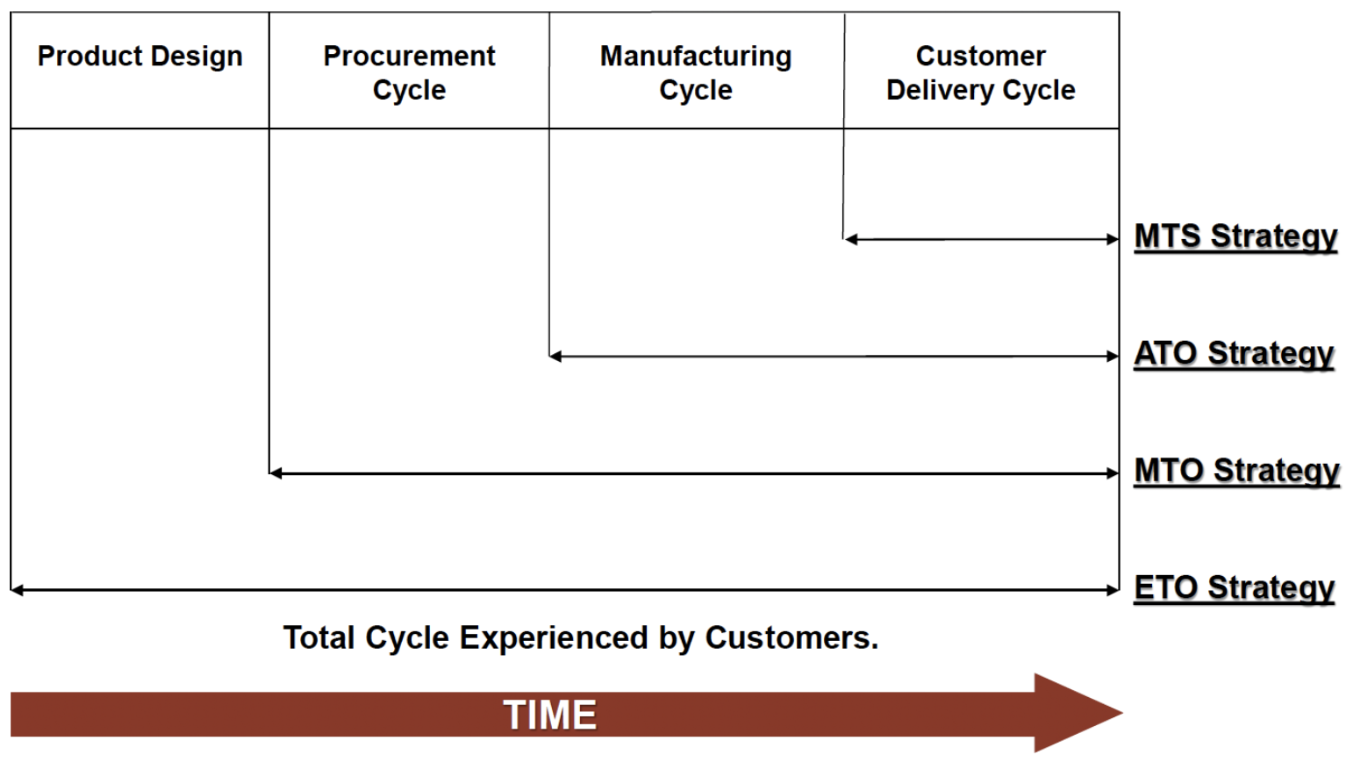
Intermittent manufacturing process
used to produce a large variety of products with different processing requirements in lower volumes
Repetitive manufacturing process
used to produce one or a few standardized products in high volumes
Types of manufacturing processes
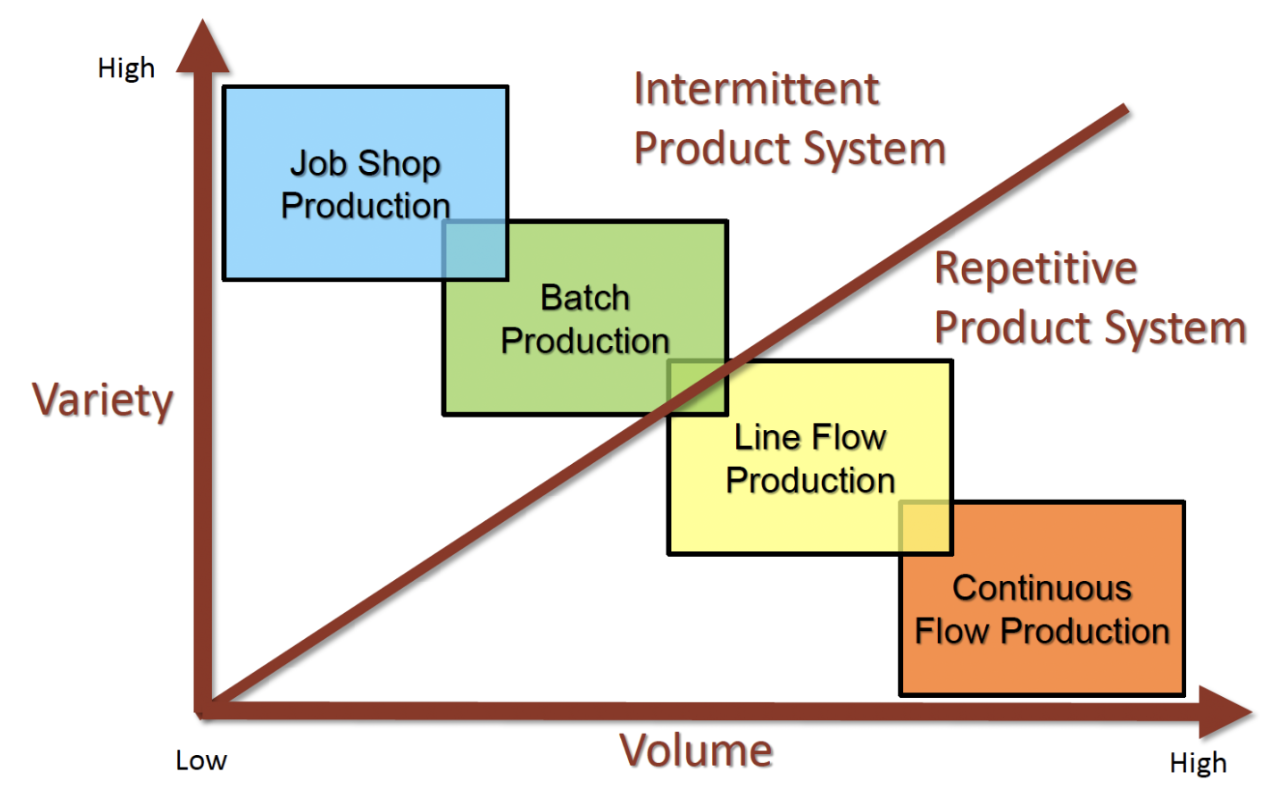
Job shop production (aka project production)
Creates a custom product for each customer, generally one at a time
intermittent
ETO, MTO
long lead time
Batch production
Manufacturing of a small fixed quantity of an item in a single production run
Each individual item in the batch goes through one stage of production process before the whole batch moves on to the next stage
Aims to achieve better use of equipment
Produces good quality products more economically than manufacturing them individually
intermittent
MTO, ATO
long lead time
Line flow production (aka mass production)
For standardized products with a limited number of variations
When one task is finished, the next task must start immediately → time taken on each task must be equal
repetitive
limited variety
ATO, MTS
short lead time
Continuous flow production
Raw materials run through a series of inflexible processes
Generally highly automated and workers act as monitors rather than as active participants over 24 hr day
Ex.: oil refining; laundry detergent
repetitive
limited variety
MTS
short lead time
Total cost of manufacturing
Complete cost of producing and delivering products, including fixed and variable costs from manufacturing, storing, and delivery
generally expressed as cost per unit
TCM vs. strategic alternatives - as volume goes up:
Manufacturing and Procurement costs go down due to economies of scale
Inventory and Warehousing costs go up
Transportation costs go down, but level off at high volumes as the shipping container gets filled to capacity and another container must be used
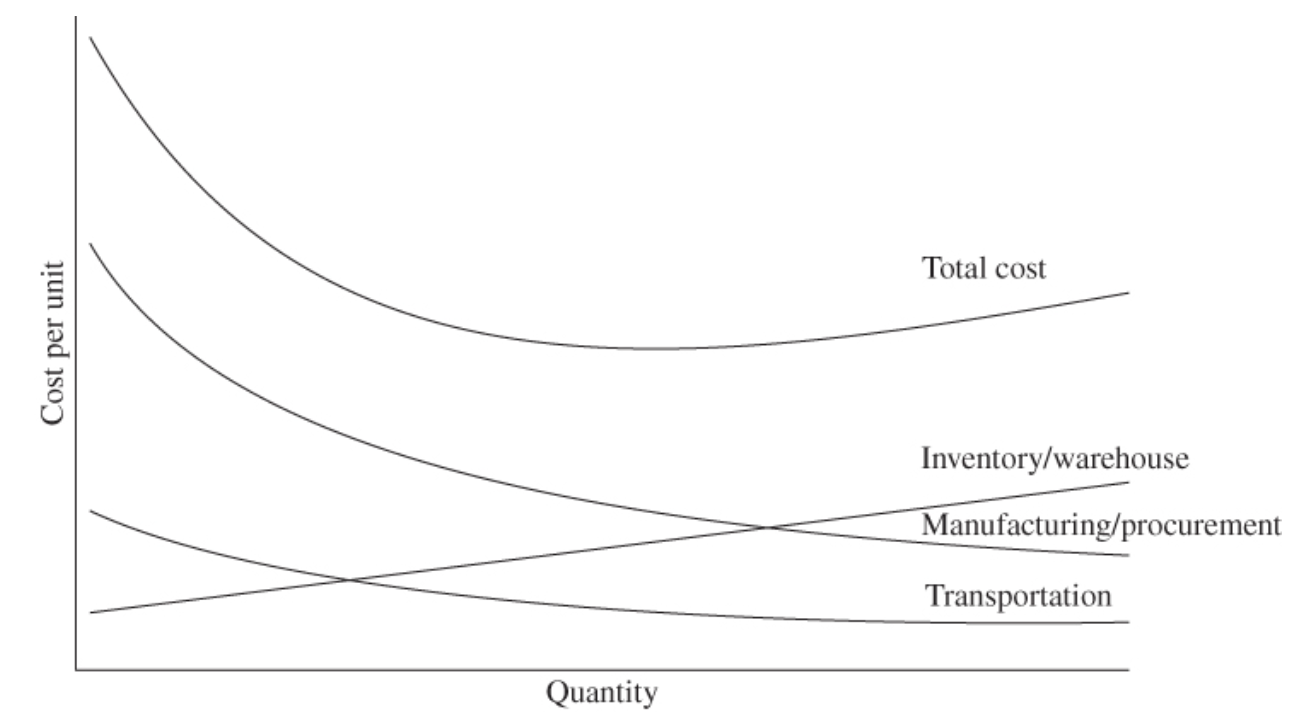
LEAN Manufacturing
A management philosophy based on the Toyota Production System, aiming to eliminate waste in the customers’ eyes
use value stream mapping as primary work unit
focus on improving process performance using learn-by-doing approach
standard in many industries
Value stream map
Shows information flows from customer to supplier, driving material flow back to the customer based on requirements
Value
inherent worth of a product as judged by the customer and reflected in its selling price and market demand